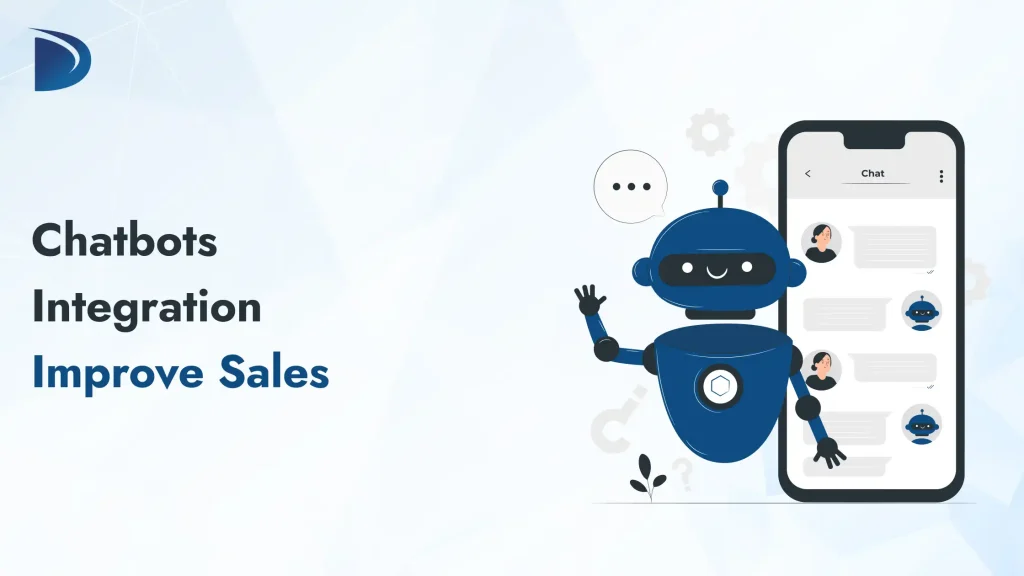Table of Contents
Visitors often leave without buying simply because no one is there to answer their questions. They may be interested, but one small doubt or delay is enough to stop the sale. This is exactly where chatbots help. When used the right way, chatbot integration improves sales by offering instant support, guiding decisions, and keeping buyers engaged.
In this blog, we’ll cover what chatbots are, how they work, and how they help turn interest into action.
What Are Sales Chatbots and How Do They Work?
Sales chatbots are built to help people during the buying process. They talk to visitors on your website or app, answer product-related questions, and help move them closer to making a purchase. They may sound like a person, but it’s smart software doing the work in the background.
Instead of waiting for someone from your team, users can get quick answers, find what they’re looking for, or ask about pricing and availability. Sales chatbots are like helpful guides that don’t take breaks.
Here’s how they actually work:
- They read what someone types and match it with the most helpful response.
- Some use simple rules, while others use AI to understand real conversation.
- They connect to tools like product catalogs, CRMs, or pricing systems to share live details.
- Many can remember past chats or actions, which helps keep the next steps clear.
- They handle many users at the same time without delays or missed messages.
- Some use buttons or quick replies so people don’t even have to type.
How Chatbots Integration Supports Sales and Customer Care
Works 24/7 Without Breaks
Many people shop outside normal hours. Late nights or weekends are common times to browse. Chatbots stay active all the time and respond instantly.
This means customers get help whenever they need it. That extra availability keeps more sales moving, even when staff are offline.
Handles Many Customers at Once
During busy times, one person can only talk to a few customers at once. This causes long wait times and lost sales.
Chatbots can chat with many visitors at the same time. No one waits, and every question gets answered quickly.
Gathers Useful Data for Better Sales
Chatbots collect helpful details from every chat. This reveals common questions and where visitors face trouble.
Businesses use this information to update product details and clear up confusion, making it easier for customers to buy.
Checks Product Availability Quickly
Finding out if a product is in stock is a key step. Chatbots can instantly check and tell visitors if an item is available.
This saves customers time and stops frustration. It also lets businesses offer alternatives or notify when stock returns.
Offers Personalized Recommendations
Chatbots ask a few simple questions about needs or budget. Then, they suggest products that fit best.
This helps buyers find what suits them faster. Personalized help builds trust and speeds up decisions.
Shortens the Sales Journey
Shopping online can get slow if people have to search or wait for answers. Chatbots reply fast and guide visitors step by step.
This keeps customers moving toward checkout without getting stuck. A quick, smooth process leads to more sales.
Reduces Lost Sales with Timely Offers
People sometimes hesitate before buying. They might compare prices or check shipping costs.
Chatbots notice this and mention discounts, coupon codes, or free shipping. These offers often help close the sale.
Schedules Calls or Follow-Ups
Some questions need a real person. Chatbots can schedule calls or send reminders for follow-up talks.
This keeps communication open and stops interested buyers from leaving without answers.
Understands Language and Emotions
Customers speak many languages and have different feelings while shopping. Chatbots can switch languages to match visitors.
They also sense if someone is frustrated or confused. The chatbot then responds kindly or passes the chat to a human.
Tips for Using Chatbots to Boost Sales
Keep responses clear and simple
Make sure the chatbot gives easy-to-understand answers. Confusing replies can push visitors away.
Use quick reply buttons
Buttons help customers pick answers faster without typing. This keeps the chat smooth and speedy.
Offer personalized help
Ask a few simple questions to suggest the right products or deals. Personal touches encourage buying.
Connect chatbots with your sales tools
Link chatbots to product info, stock systems, and CRMs to give accurate answers and track leads.
Know when to pass to a human
If the chatbot can’t help or senses frustration, it should quickly hand off to a real person.
Keep chat available 24/7
Customers shop any time. Make sure chatbots are always ready to answer.
Review chatbot data often
Look at what questions come up most and update the chatbot to cover those better.
Conclusion
Visitors often leave without buying when small doubts delay their decision. Chatbots help by giving quick answers, offering product suggestions, and staying active around the clock. They also guide users through checkout and reduce missed chances. This is how chatbots integration improves sales, by making the process easier from start to finish.

